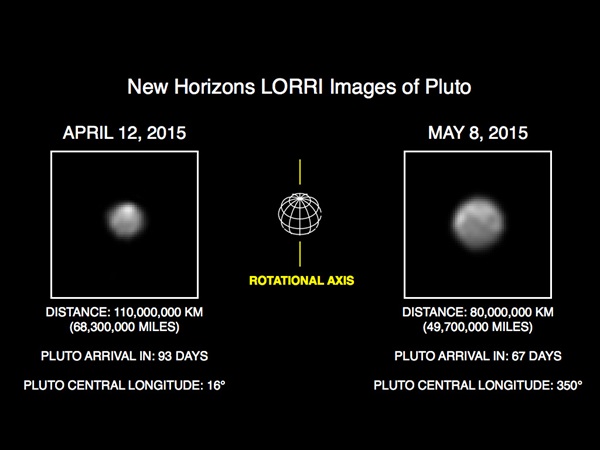Key Takeaways:
The April images are shown on the left, with the May images on the right. All have been rotated to align Pluto’s rotational axis with the vertical direction (up-down), as depicted schematically in the center panel. Between April and May, Pluto appears to get larger as the spacecraft gets closer, with Pluto’s apparent size increasing by approximately 50 percent. Pluto rotates around its axis every 6.4 Earth days, and these images show the variations in Pluto’s surface features during its rotation.
These images are displayed at four times the native LORRI image size, and have been processed using a method called deconvolution, which sharpens the original images to enhance features on Pluto. Deconvolution can occasionally add “false” details, so the finest details in these pictures will need to be confirmed by images taken from closer range in the next few weeks. All of the images are displayed using the same linear brightness scale.
What a difference 20 million miles (32 million kilometers) makes! Images of Pluto from NASA’s New Horizons spacecraft are growing in scale as the spacecraft approaches its mysterious target. The new images, taken May 8–12 using a powerful telescopic camera and downlinked last week, reveal more detail about Pluto’s complex and high-contrast surface.
The images were taken from just under 50 million miles (77 million km) away, using the Long-Range Reconnaissance Imager (LORRI) on New Horizons. Because New Horizons was approximately 20 million miles closer to Pluto in mid-May than in mid-April, the new images contain about twice as many pixels on the object as images made in mid-April.
A technique called image deconvolution sharpens the raw, unprocessed pictures beamed back to Earth. In the April images, New Horizons scientists determined that Pluto has broad surface markings — some bright, some dark — including a bright area at one pole that may be a polar cap. The newer imagery released here shows finer details. Deconvolution can occasionally produce spurious details, so the finest details in these images will need confirmation from images to be made from closer range in coming weeks.
“These new images show us that Pluto’s differing faces are each distinct, likely hinting at what may be very complex surface geology or variations in surface composition from place to place,” said Alan Stern of the Southwest Research Institute in Boulder, Colorado. “These images also continue to support the hypothesis that Pluto has a polar cap whose extent varies with longitude; we’ll be able to make a definitive determination of the polar bright region’s iciness when we get compositional spectroscopy of that region in July.”
The images New Horizons returns will dramatically improve in coming weeks as the spacecraft speeds closer to its July 14 encounter with the Pluto system, covering about 750,000 miles (1,200,000 km) per day.
“By late June, the image resolution will be four times better than the images made May 8–12, and by the time of closest approach, we expect to obtain images with more than 5,000 times the current resolution,” said Hal Weaver from the Johns Hopkins University Applied Physics Laboratory (APL) in Laurel, Maryland.
Following a January 2006 launch, New Horizons is currently about 2.95 billion miles (4.75 billion km) from home; the spacecraft is healthy and all systems are operating normally.













